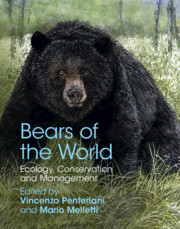Book contents
- Bears of the World
- Bears of the World
- Copyright page
- Dedication
- Frontispiece
- Contents
- Contributors
- Foreword
- Acknowledgments
- Introduction
- Part I Systematics, Ecology, and Behavior
- Part II Species Accounts
- Part III Human–Bear Coexistence
- Chapter 15 Human–Bear Conflicts at the Beginning of the Twenty-First Century: Patterns, Determinants, and Mitigation Measures
- Chapter 16 Principles of Human–Bear Conflict Management in Challenging Environments
- Chapter 17 Patterns of Bear Attacks on Humans, Factors Triggering Risky Scenarios, and How to Reduce Them
- Chapter 18 Effects of Human Disturbance on Brown Bear Behavior
- Chapter 19 Bears in Human-Modified Landscapes: The Case Studies of the Cantabrian, Apennine, and Pindos Mountains
- Part IV Conservation and ManagementConservation and Management
- Index
- Miscellaneous Endmatter
- Plate Section (PDF Only)
- References
Chapter 16 - Principles of Human–Bear Conflict Management in Challenging Environments
from Part III - Human–Bear Coexistence
Published online by Cambridge University Press: 16 November 2020
- Bears of the World
- Bears of the World
- Copyright page
- Dedication
- Frontispiece
- Contents
- Contributors
- Foreword
- Acknowledgments
- Introduction
- Part I Systematics, Ecology, and Behavior
- Part II Species Accounts
- Part III Human–Bear Coexistence
- Chapter 15 Human–Bear Conflicts at the Beginning of the Twenty-First Century: Patterns, Determinants, and Mitigation Measures
- Chapter 16 Principles of Human–Bear Conflict Management in Challenging Environments
- Chapter 17 Patterns of Bear Attacks on Humans, Factors Triggering Risky Scenarios, and How to Reduce Them
- Chapter 18 Effects of Human Disturbance on Brown Bear Behavior
- Chapter 19 Bears in Human-Modified Landscapes: The Case Studies of the Cantabrian, Apennine, and Pindos Mountains
- Part IV Conservation and ManagementConservation and Management
- Index
- Miscellaneous Endmatter
- Plate Section (PDF Only)
- References
Summary
Human–bear conflicts differ geographically across the range of eight bear species. First, a brief summary of how conflict studies started in international relationships and then entered to the field of wildlife conservation is given. Then, an overall picture of human–bear conflict management is provided and how current conflict management plans can be improved by considering them as logic models is discussed. Finally, 12 key factors for managing human–bear conflict in challenging environments are presented.
- Type
- Chapter
- Information
- Bears of the WorldEcology, Conservation and Management, pp. 227 - 238Publisher: Cambridge University PressPrint publication year: 2020

